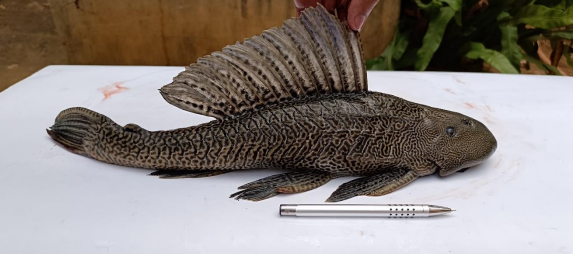CSIR - Centre for Cellular & Molecular Biology
Council of Scientific and Industrial Research
The Innovation Engine of India
Date : August 30, 2024

Hyderabad, 10th May, 2024: Invasive species are introduced species in a new ecosystem that can grow rapidly and often lack predators. As a result, they can threaten the new ecosystem that they now thrive in and livelihoods that depend on it. They are especially concerning in biodiversity-rich countries such as India.
Neeldeep Ganguly and Dr G Umapathy, Chief Scientist at CSIR-Centre for Cellular and Molecular Biology (CCMB), Hyderabad bring our focus on the aquatic invasive species. They have developed an eDNA-based quantitative PCR assay to map the presence and spread of invasive armored sailfin catfish in the water bodies of Eastern Ghats. This is a fish that was once introduced for its unique appearance and its ability to clean algal growth in tanks and aquaria. But now it has spread to 60% water bodies of Eastern Ghats, and also damaging fishing nets and ecosystem. eDNA is environmental DNA that they collect from water samples. In the mix of many kinds of DNA in such water samples, they look for DNA of the concerned catfish specifically. Not just the mere presence of the fish, the method can also tell the extent of the spread of the fish. The work is now published in the journal Environmental DNA.
“Prior detection of invasive fish is crucial for preserving ecosystems, reducing loss of fish catch and supporting ecological equilibrium. Our technique helps in early detection of the armored sailfin catfish and its distribution in the Eastern Ghats waterbodies. This significantly adds to continuing invasive species management efforts that directly help the survival of native and economically important fishes,” said Dr Umapathy, the lead author of the study
This new method brings in advantages over the existing methods. “The conventional methods of detection of invasive species, which can only be used in smaller geographical coverage, and is labour and cost-intensive. On the other hand, the environmental DNA approach is reliable, accurate, and low cost, it can be used in a large landscape like Eastern Ghats water bodies in a few months’ time. In a single lab test, about 20 waterbodies can also be tested for the presence of invasive species using the eDNA approach accurately, once the method is in place,” said Dr Vinay K Nandicoori, Director, CCMB.
 Advertisement no 07/10 for the post Junior Scientist.
Advertisement no 07/10 for the post Junior Scientist.
 List of shortlisted candidates for the temporary positions against CCMB Web Notif.No.0724/B- [26-08-2024]
List of shortlisted candidates for the temporary positions against CCMB Web Notif.No.0724/B- [26-08-2024]
 Result of selected candidates for the temporary positions against CCMB Web Notif.No.0724/A - [21-08-2024]
Result of selected candidates for the temporary positions against CCMB Web Notif.No.0724/A - [21-08-2024]
 Notification of Schedule for Trade Test and Downloading of Admit Cards for the posts of Gr. II (1)/Technician (1) against Advt.No:01/2021 - [19-08-2024]
Notification of Schedule for Trade Test and Downloading of Admit Cards for the posts of Gr. II (1)/Technician (1) against Advt.No:01/2021 - [19-08-2024]
 List of selected candidates for the temporary positions against CCMB Web Notif.No.0624/A - [14-08-2024]
List of selected candidates for the temporary positions against CCMB Web Notif.No.0624/A - [14-08-2024]
 List of shortlisted candidates for the temporary positions against CCMB Web Notif.No.0724/A - [02-08-2024]
List of shortlisted candidates for the temporary positions against CCMB Web Notif.No.0724/A - [02-08-2024]
 Notification No.0824/A for various temporary positions on contractual basis- [02-08-2024]
Notification No.0824/A for various temporary positions on contractual basis- [02-08-2024]
 Notification No.0724/B for various temporary positions on contractual basis - [29-07-2024]
Notification No.0724/B for various temporary positions on contractual basis - [29-07-2024]
 List of shortlisted candidates for the temporary positions against CCMB Web Notif.No.0624/A- [19-07-2024]
List of shortlisted candidates for the temporary positions against CCMB Web Notif.No.0624/A- [19-07-2024]
 List of Provisionally empanelled candidates for Engagement as Project staff Vide Notif.No.2024/1 - [15-07-2024]
List of Provisionally empanelled candidates for Engagement as Project staff Vide Notif.No.2024/1 - [15-07-2024]